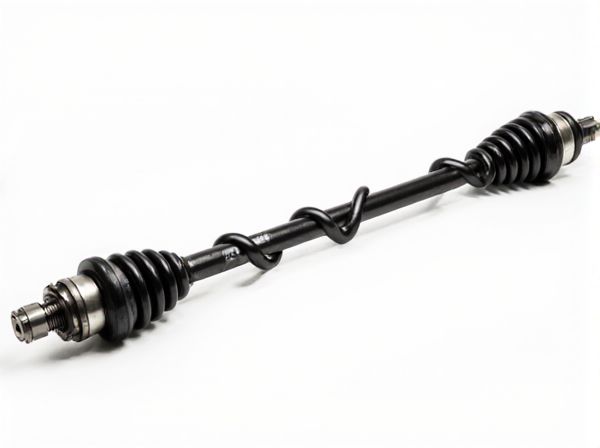
Photo illustration: High-speed Driveshaft vs Low-speed Driveshaft
High-speed driveshafts are designed for applications requiring rapid rotational speeds, providing efficient power transfer with minimal vibration and enhanced durability. Low-speed driveshafts, on the other hand, prioritize torque transmission and robustness for heavy-duty tasks where speed is less critical. Understanding the difference between these driveshaft types helps optimize your vehicle's performance and longevity.
Table of Comparison
| Feature | High-speed Driveshaft | Low-speed Driveshaft |
|---|---|---|
| Operating Speed | Above 3000 RPM | Below 3000 RPM |
| Material | Lightweight alloys (aluminum, carbon fiber) | Steel or heavier metals |
| Design | Precision balanced, slim profile | Robust, thicker shaft |
| Vibration | Minimized with advanced dampers | Higher vibration levels |
| Durability | Optimized for high RPM stress | Built for heavy torque loads |
| Applications | Sports cars, performance vehicles | Trucks, heavy-duty vehicles |
| Maintenance | Requires regular inspection for balance | Less frequent, focus on torsional integrity |
Introduction to Driveshafts: High-speed vs Low-speed
Driveshafts transmit torque from the engine to the wheels, with high-speed driveshafts designed for rapid rotational speeds typically found in performance vehicles, while low-speed driveshafts operate under lower rotational speeds, common in heavy-duty or off-road applications. High-speed driveshafts require precision balancing and lightweight materials like carbon fiber or aluminum to minimize vibration and increase efficiency. Low-speed driveshafts emphasize durability and torque capacity, often constructed from steel with robust universal joints to withstand harsh operating conditions.
Core Differences Between High-speed and Low-speed Driveshafts
High-speed driveshafts operate at elevated rotational speeds, often exceeding 5,000 RPM, requiring precision balancing and use of lightweight, high-strength materials such as carbon fiber or alloy steel. Low-speed driveshafts function at lower RPMs, typically below 3,000, and prioritize durability and torque transmission with conventional materials like steel or aluminum, focusing on strength over weight savings. The core differences lie in speed capacity, material composition, and design priorities, with high-speed driveshafts optimized for reduced vibration and inertia, while low-speed driveshafts emphasize torque handling and robust construction.
Materials Used in High-speed and Low-speed Driveshafts
High-speed driveshafts commonly utilize advanced materials such as carbon fiber composites and high-strength steel alloys to withstand elevated rotational speeds and reduce inertial mass. Low-speed driveshafts often incorporate traditional materials like mild steel or cast iron, prioritizing durability and cost-effectiveness over weight reduction. The choice of materials directly impacts the driveshaft's performance, vibration absorption, and longevity in varying operational conditions.
Performance Characteristics and Efficiency
High-speed driveshafts typically provide superior torque transmission efficiency and enable faster rotational speeds, making them ideal for performance vehicles requiring quick acceleration and high power output. Low-speed driveshafts excel in durability and vibration damping, often resulting in smoother power delivery and reduced mechanical stress in heavy-duty or off-road applications. Performance characteristics favor high-speed driveshafts for agility and responsiveness, whereas efficiency in energy transfer and longevity often align with low-speed driveshaft designs.
Applications of High-speed Driveshafts
High-speed driveshafts are primarily used in applications where rapid rotational speeds and precise torque transmission are critical, such as in race cars, aircraft, and industrial machinery like CNC machines. These driveshafts are designed with advanced materials and balance techniques to handle the stresses of high RPMs without compromising performance or durability. Their ability to maintain stability at high speeds makes them essential for achieving optimal efficiency and responsiveness in high-performance mechanical systems.
Applications of Low-speed Driveshafts
Low-speed driveshafts are primarily used in applications requiring high torque at low rotational speeds, such as construction machinery, agricultural equipment, and heavy-duty trucks. These driveshafts provide enhanced durability and torque transmission capacity, making them ideal for off-road vehicles and industrial machinery operating under heavy load conditions. Compared to high-speed driveshafts, low-speed variants are optimized for maximum strength and reliability rather than rotational velocity.
Durability and Maintenance Comparison
High-speed driveshafts generally experience greater stress due to higher rotational velocities, which can lead to increased wear and a higher likelihood of fatigue failure, making durability a critical factor in their design. Low-speed driveshafts tend to be more robust with thicker shafts and simpler joints, resulting in longer service intervals and reduced maintenance requirements. Regular lubrication and inspection are essential for both types, but high-speed driveshafts often demand more frequent maintenance to ensure optimal performance and longevity.
Cost Analysis: High-speed vs Low-speed Driveshafts
High-speed driveshafts generally incur higher initial costs due to advanced materials and precision engineering required to withstand greater rotational speeds and reduce vibrations. Low-speed driveshafts benefit from simpler designs and less stringent material requirements, resulting in lower manufacturing and maintenance expenses. Long-term cost efficiency depends on application demands, with high-speed driveshafts offering better performance in high RPM scenarios, while low-speed variants provide cost advantages in less demanding environments.
Selecting the Right Driveshaft for Your Application
Selecting the right driveshaft for your application depends on factors such as torque capacity, rotational speed, and load requirements. High-speed driveshafts are ideal for applications requiring fast rotation with minimal vibration, often using lightweight, balanced materials for efficient power transmission. Low-speed driveshafts accommodate heavier loads and increased torque, prioritizing durability and strength for industrial or heavy machinery use.
Future Trends in Driveshaft Technology
High-speed driveshafts are evolving with advancements in lightweight composite materials and enhanced precision engineering, enabling higher rotational speeds and improved efficiency in electric and hybrid vehicles. Low-speed driveshafts benefit from innovations in adaptive damping and robust design to optimize torque transmission and durability in heavy-duty applications. Future trends emphasize smart sensors integration and real-time monitoring systems to predict maintenance needs and extend driveshaft lifespan across both high-speed and low-speed variants.
 caratoz.com
caratoz.com